HDFS Tutorial – A Complete Hadoop HDFS Overview
Learn one of the core components of Hadoop that is Hadoop Distributed File System and explore its features and many more.
The objective of this Hadoop HDFS Tutorial is to take you through what is HDFS in Hadoop, what are the different nodes in Hadoop HDFS, how data is stored in HDFS, HDFS architecture, HDFS features like distributed storage, fault tolerance, high availability, reliability, block, etc.
In this HDFS tutorial, we will also discuss HDFS operations; that is, how to write and read data from HDFS, and Rack awareness. After reading this article, you will come to know the reason for learning Hadoop HDFS and how it will give a boost to your career in the IT sector. The main objective behind this Hadoop HDFS tutorial is to cover all the concepts of the Hadoop Distributed File System in great detail.
HDFS Tutorial – Introduction
Hadoop Distributed File system – HDFS is the world’s most reliable storage system. HDFS is a Filesystem of Hadoop designed for storing very large files running on a cluster of commodity hardware. It is designed on the principle of storage of less number of large files rather than the huge number of small files.
Hadoop HDFS provides a fault-tolerant storage layer for Hadoop and its other components. HDFS Replication of data helps us to attain this feature. It stores data reliably, even in the case of hardware failure. It provides high throughput access to application data by providing the data access in parallel.
Let us move ahead in this Hadoop HDFS tutorial with major areas of the Hadoop Distributed File System.
Install Hadoop 3.x on Ubuntu on Single Node Cluster
HDFS Nodes
As we know, Hadoop works in master-slave fashion, HDFS also has two types of nodes that work in the same manner. These are the NameNode(s) and the DataNodes.
1. HDFS Master (Namenode)
NameNode regulates file access to the clients. It maintains and manages the slave nodes and assigns tasks to them. NameNode executes file system namespace operations like opening, closing, and renaming files and directories.
NameNode runs on the high configuration hardware.
2. HDFS Slave (Datanode)
There are n number of slaves (where n can be up to 1000) or DataNodes in the Hadoop Distributed File System that manages storage of data. These slave nodes are the actual worker nodes that do the tasks and serve read and write requests from the file system’s clients.
They perform block creation, deletion, and replication upon instruction from the NameNode. Once a block is written on a DataNode, it replicates it to other DataNode, and the process continues until creating the required number of replicas.
DataNodes runs on commodity hardware having an average configuration.
4. Hadoop HDFS Daemons
There are two daemons which run on HDFS for data storage:
- Namenode: This is the daemon that runs on all the masters. NameNode stores metadata like filename, the number of blocks, number of replicas, a location of blocks, block IDs, etc.
This metadata is available in memory in the master for faster retrieval of data. In the local disk, a copy of the metadata is available for persistence. So NameNode memory should be high as per the requirement. - Datanode: This is the daemon that runs on the slave. These are actual worker nodes that store the data.
To learn more about how data flows in Hadoop MapReduce, follow this MapReduce tutorial.
Data storage in HDFS
Hadoop HDFS broke the files into small pieces of data known as blocks. The default block size in HDFS is 128 MB. We can configure the size of the block as per the requirements. These blocks are stored in the cluster in a distributed manner on different nodes. This provides a mechanism for MapReduce to process the data in parallel in the cluster.
HDFS stores multiple copies of each block across the cluster on different nodes. This is a replication of data. By default, the HDFS replication factor is 3. Hadoop HDFS provides high availability, fault tolerance, and reliability.
HDFS splits a large file into n number of small blocks and stores them on different DataNodes in the cluster in a distributed manner. It replicates each block and stored them across different DataNodes in the cluster.
Rack Awareness in Hadoop HDFS
Hadoop runs on a cluster of computers spread commonly across many racks.
NameNode places replicas of a block on multiple racks for improved fault tolerance.
NameNode tries to place at least one replica of a block in a different rack so that if a complete rack goes down, then also the system will be highly available.
Optimize replica placement distinguishes HDFS from other distributed file systems. The purpose of a rack-aware replica placement policy is to improve data reliability, availability, and network bandwidth utilization.
For more understanding, learn Rack Awareness in detail.
HDFS Architecture
This architecture gives you a complete picture of the Hadoop Distributed File System. There is a single NameNode that stores metadata, and there are multiple DataNodes that do actual storage work. Nodes are arranged in racks, and replicas of data blocks are stored on different racks in the cluster to provide fault tolerance.
In the remaining section of this tutorial, we will see how read and write operations are performed in HDFS? To read or write a file in HDFS, the client needs to interact with NameNode. HDFS applications need a write-once-read-many access model for files. A file, once created and written, cannot be edited.
NameNode stores metadata, and DataNode stores actual data. The client interacts with NameNode for performing any tasks, as NameNode is the centerpiece in the cluster.
There are several DataNodes in the cluster which store HDFS data in the local disk. DataNode sends a heartbeat message to NameNode periodically to indicate that it is alive. Also, it replicates data to other DataNode as per the replication factor.
Hadoop HDFS Features
In the HDFS tutorial, let us now see various features of Hadoop Distributed File System
a. Distributed Storage
HDFS stores data in a distributed manner. It divides the data into small pieces and stores it on different DataNodes in the cluster. In this manner, the Hadoop Distributed File System provides a way to MapReduce to process a subset of large data sets broken into blocks, parallelly on several nodes. MapReduce is the heart of Hadoop, but HDFS is the one who provides it all these capabilities.
b. Blocks
HDFS splits huge files into small chunks known as blocks. Block is the smallest unit of data in a filesystem. We (client and admin) do not have any control on the block like block location. NameNode decides all such things.
HDFS default block size is 128 MB. We can increase or decrease the block size as per our need. This is unlike the OS filesystem, where the block size is 4 KB.
If the data size is less than the block size of HDFS, then block size will be equal to the data size.
For example, if the file size is 129 MB, then 2 blocks will be created for it. One block will be of default size 128 MB, and the other will be 1 MB only and not 128 MB as it will waste the space (here block size is equal to data size). Hadoop is intelligent enough not to waste the rest of 127 MB. So it is allocating 1 MB block only for 1 MB data.
The major advantage of storing data in such block size is that it saves disk seek time and another advantage is in the case of processing as mapper processes 1 block at a time. So 1 mapper processes large data at a time.
c. Replication
Hadoop HDFS creates duplicate copies of each block. This is known as replication. All blocks are replicated and stored on different DataNodes across the cluster. It tries to put at least 1 replica in a different rack.
What do you mean by rack?
DataNodes are arranged in racks. All the nodes in a rack are connected by a single switch, so if a switch or complete rack is down, data can be accessed from another rack. We will see it further in the rack awareness section.
As seen earlier in this Hadoop HDFS tutorial, the default replication factor is 3, and this can be changed to the required values according to the requirement by editing the configuration files (hdfs-site.xml).
d. High Availability
Replication of data blocks and storing them on multiple nodes across the cluster provides high availability of data. As seen earlier in this Hadoop HDFS tutorial, the default replication factor is 3, and we can change it to the required values according to the requirement by editing the configuration files (hdfs-site.xml).
Learn more about high availability in Hadoop.
e. Data Reliability
As we have seen in high availability in this HDFS tutorial, data is replicated in HDFS; It is stored reliably as well. Due to replication, blocks are highly available even if some node crashes or some hardware fails. If the DataNode fails, then the block is accessible from other DataNode containing a replica of the block. Also, if the rack goes down, the block is still available on the different rack. This is how data is stored reliably in HDFS and provides fault-tolerant and high availability.
f. Fault Tolerance
HDFS provides a fault-tolerant storage layer for Hadoop and other components in the ecosystem.
HDFS works with commodity hardware (systems with average configurations) that has high chances of getting crashed at any time. Thus, to make the entire system highly fault-tolerant, HDFS replicates and stores data in different places.
Learn more about fault tolerance in Hadoop.
g. Scalability
Scalability means expanding or contracting the cluster. We can scale Hadoop HDFS in 2 ways.
- Vertical Scaling: We can add more disks on nodes of the cluster.
For doing this, we need to edit the configuration files and make corresponding entries of newly added disks. Here we need to provide downtime though it is very less. So people generally prefer the second way of scaling, which is horizontal scaling. - Horizontal Scaling: Another option of scalability is of adding more nodes to the cluster on the fly without any downtime. This is known as horizontal scaling.
We can add as many nodes as we want in the cluster on the fly in real-time without any downtime. This is a unique feature provided by Hadoop.
To learn the difference between Hadoop 2.x and Hadoop 3.x refer to this comparison guide.
h. High throughput access to application data
Hadoop Distributed File System provides high throughput access to application data. Throughput is the amount of work done in a unit time. It describes how fast the data is getting accessed from the system, and it is usually used to measure the performance of the system.
In HDFS, when we want to perform a task or an action, then the work is divided and shared among different systems. So all the systems will be executing the tasks assigned to them independently and in parallel. So the work will be completed in a very short period of time.
Thus, by reading data in parallel HDFS gives good throughput.
9. Hadoop HDFS Operations
In Hadoop, we need to interact with the file system either by programming or by the command-line interface (CLI). Learn how to interact with HDFS using CLI from this commands manual.
Hadoop Distributed File System has many similarities with the Linux file system. So we can do almost all the operations on the HDFS File System that we can do on a local file system like create a directory, copy the file, change permissions, etc.
It also provides different access rights like read, write, and execute to users, groups, and others.
We can browse the file system here by the browser that would be like http://master-IP:50070. By pointing the browser to this URL, you can get the cluster information like space used / available, the number of live nodes, the number of dead nodes, etc.
1. HDFS Read Operation
Whenever a client wants to read any file from HDFS, the client needs to interact with NameNode as NameNode is the only place that stores metadata about DataNodes. NameNode specifies the address or the location of the slaves where data is stored.
The client will interact with the specified DataNodes and read the data from there. For security/authentication purposes, NameNode provides a token to the client, which it shows to the DataNode for reading the file.
In the Hadoop HDFS read operation, if the client wants to read data that is stored in HDFS, it needs to interact with NameNode first. So the client interacts with distributed file system API and sends a request to NameNode to send block location. Thus, NameNode checks if the client has sufficient privileges to access the data or not. If the client have sufficient privileges, then NameNode will share the address at which data is stored in the DataNode.
With the address, NameNode also shares a security token with the client, which it needs to show to DataNode before accessing the data for authentication purposes.
When a client goes to DataNode for reading the file, after checking the token, DataNode allows the client to read that particular block. A client then opens the input stream and starts reading data from the specified DataNodes. Hence, In this manner, the client reads data directly from DataNode.
During the reading of a file, if the DataNode goes down suddenly, then a client will again go to the NameNode, and the NameNode will share another location where that block is present.
Learn more about File read operation in Hadoop.
2. HDFS Write Operation
As seen while reading a file, the client needs to interact with NameNode. Similarly, for writing a file, the client needs to interact with the NameNode.
NameNode provides the address of the slaves on which data has to be written by the client.
Once the client finishes writing the block, the slave starts replicating the block into another slave, which then copies the block to the third slave. This is the case when the default replication factor of 3 is used. After the required replicas are created, it sends a final acknowledgment to the client. The authentication process is similar, as seen in the read section.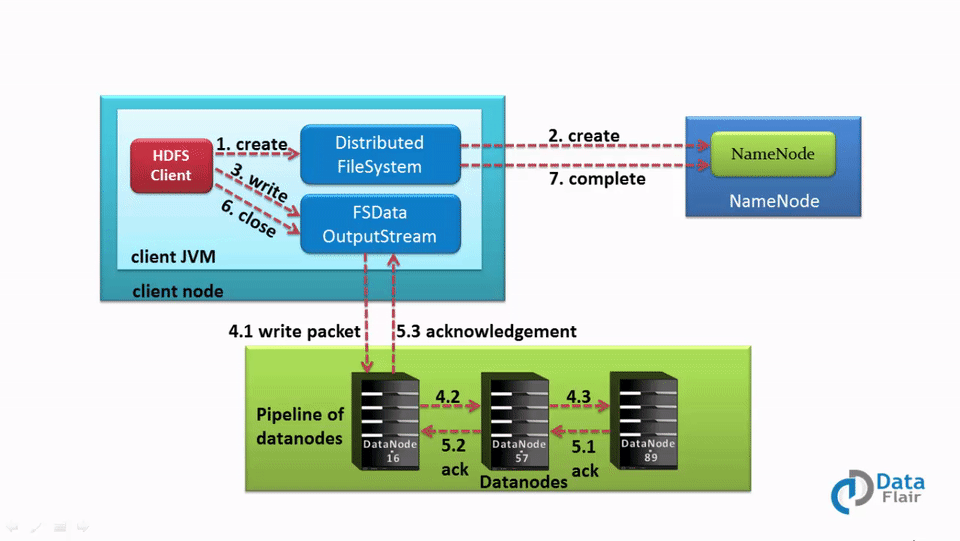
Whenever a client needs to write any data, it needs to interact with the NameNode. So the client interacts with distributed file system API and sends a request to NameNode to send a slave location.
NameNode shares the location at which data has to be written.
Then the client interacts with the DataNode at which data has to be written and starts writing the data through the FS data output stream. Once the data is written and replicated, the DataNode sends an acknowledgment to the client informing that the data is written completely.
We have already discussed in this Hadoop HDFS tutorial write a file; the client needs to interact with NameNode first and then start writing data on DataNodes as informed by NameNode.
As soon as the client finishes writing the first block, the first DataNode will copy the same block to other DataNode. Thus this DataNode after receiving the block starts copying this block to the third DataNode. Third sends an acknowledgment to second, the second DataNode sends an acknowledgment to the first DataNode, and then the first DataNode sends the final acknowledgment (in the case of default replication factor).
The client is sending just 1 copy of data irrespective of our replication factor, while DataNodes replicate the blocks. Hence, Writing of file in Hadoop HDFS is not costly as parallelly multiple blocks are getting written on several DataNodes.
Learn more about HDFS File write operation.
Advantage of learning HDFS and how it boosts your career
Learning HDFS is very beneficial as HDFS is by far the most reliable and fault-tolerant storage available, which can be scaled up or down depending on the needs, making it really very hard for finding any replacement of HDFS for storing Big Data. So, mastering this can give you an upper hand while applying for jobs in the Hadoop-related domains. Many of the world’s biggest companies are deploying Hadoop. Companies like Amazon, Facebook, Microsoft, Google, Yahoo, IBM, and General Electrics run massive Hadoop clusters for storing and processing massive amounts of data. Therefore, as a goal-seeking IT professional, learning HDFS can help you to leave your competitors way behind and make a big leap in your career.
Summary
In short, we can say that HDFS is a Hadoop distributed filesystem that stores data across multiple nodes in a Hadoop cluster. It is highly reliable, flexible, scalable, and fault-tolerant. HDFS follows master-slave architecture. NameNode is the master that manages filesystem namespace, and the DataNodes are the slave nodes that store business data. HDFS break files into blocks and create replicas of blocks and store them on different DataNodes to provide fault tolerance. To date, there is no replacement for Hadoop HDFS. One can grab a job in top MNC’s by mastering Hadoop and its core components, that is, HDFS, MapReduce, and YARN.
Want to master HDFS? Follow the DataFlair sidebar and navigate easily to learn everything about HDFS.
In case of any queries or feedback in this HDFS tutorial feel free to connect us from the comment box below.
Keep Learning!!
Did you like this article? If Yes, please give DataFlair 5 Stars on Google

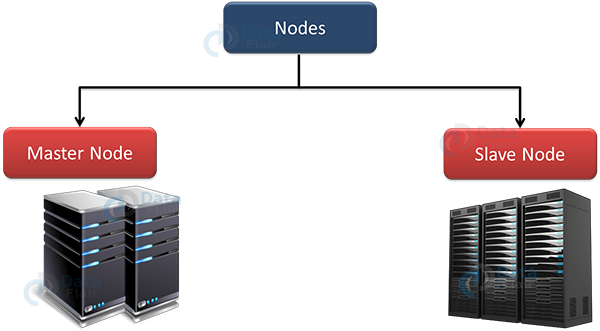
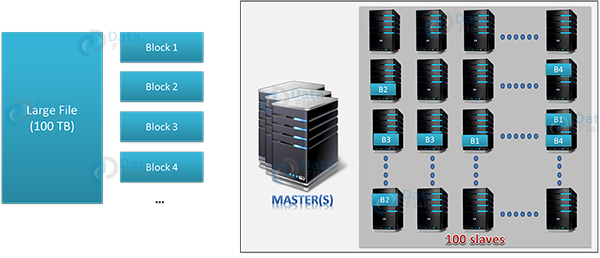
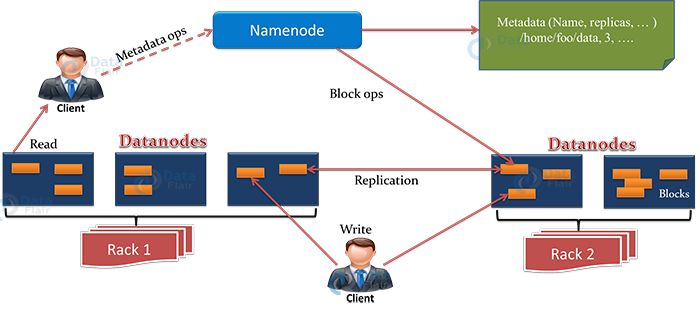
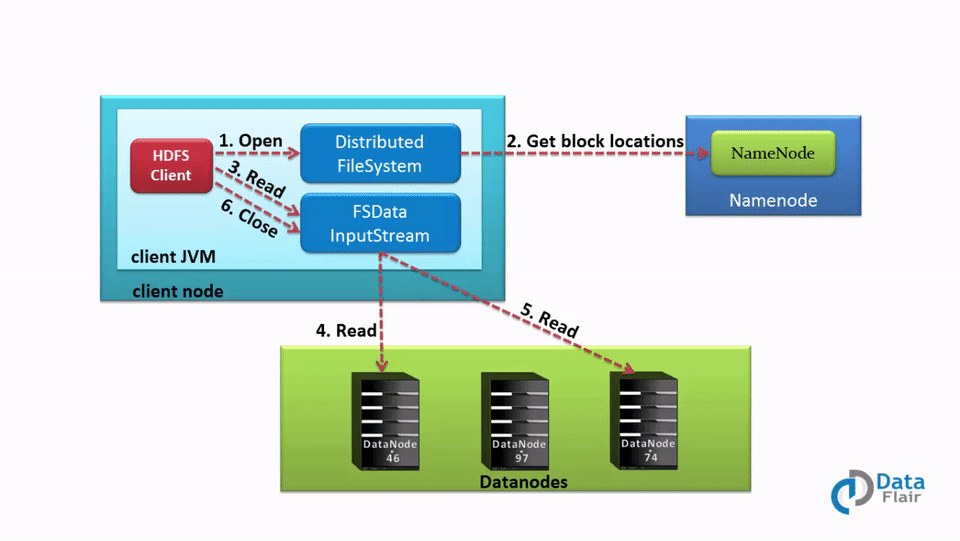


Very descriptive and comprehensive tutorial, thanks for sharing..
Thank you, Herbert, for writing such kind words to us. Keep giving feedback like this it motivates us for writing more blogs on Hadoop HDFS.
Best wishes from the site.
I visit your blogs on regular basis as I get some new topics every time that help me in fast learning the latest technologies Apache Spark, Big data hadoop and now Apache Flink as well.
Please share Flink tutorial to start with.
Hellow David,
You are a loyal reader. Thank you for sharing such positive experience on Hadoop HDFS blog. We have published a complete Flink Tutorial, which will guide you to move further in Flink.
You can start with this –
https://data-flair.training/blogs/apache-flink-tutorial-comprehensive-guide/
For hottest Big data related information you have to go to see world wide web and on internet
I found this web page as a most excellent site
for latest updates on Hadoop and other Big data technologies.
Susiem, you are just amazing, thank you for giving such a superb review on Hadoop HDFS tutorial. We regularly update our data even if we feel a slight change in the technology. We try to ensure readers like you get updated and corrected information easily at one place.
You will get many new topics on Hadoop and Big data on our website.
Keep connected with Data Flair.
This HDFS tutorial has covered every concept of Hadoop HDFS component and is well explained. I liked it. Thanks
Hellow Clash,
Glad to read your review. Hope you have visited the links given in the Hadoop HDFS tutorial. We tried to cover each and every topic related to Hadoop and HDFS. And it’s very great that our readers are liking the content. Thank you so much Clash, I really appreciate your comment.
Visit again.
Best wishes from us.
I really like your blogs very much as they are very informative. Please let me know if there is any link for
email subscription or e-newsletter service.
Kindly permit me recognize so that I may subscribe to keep getting updates.
Thanks.
Hii Chrinstine,
Thanks a lot for reading the complete Hadoop HDFS tutorial.
If you want to learn more in Hadoop with the best mentors you can mail us your details.
Contact us – [email protected]
Call – +91-8451097879
Keep visiting Data Flair for more updates on Hadoop and HDFS.
Everyone loves it when folks come together and
share thoughts. Great website, stick with it!
Hai, thanks a lot for commenting of Hadoop HDFS tutorial. We really appreciate your words for us. Keep visiting Data Flair for more Hadoop and HDFS articles.
Best wishes from us.
Everything is very open with a clear clarification of the issues.It was really informative.
Your site is very helpful. Thank you for sharing!
Hello Angelica, thank you for reading the complete Hadoop HDFS article and giving a thoughtful review. Your every appreciation contributes to our motivation. Please let us know what else you want to learn with us. We will be very glad to help you with anything,
Good post.I learn something new and challenging on your blogs
It is of great honor to us that our readers find our blogs challenging and that they take home something new every day. Keep visiting Data Flair and get more such challenging and informative tutorials on Hadoop and HDFS.
very clear explained here.. i got the clear idea on how HDFS works.
I was struggling to learn these concepts but luckily I find this site as the best one to understand. Thanks
i find it useful for understanding concepts and principle too.
Hii zysharelife,
It is really a pleasure for us that our Hadoop HDFS tutorial proves helpful to you. You can check more blogs on Hadoop at Data Flair. You will definitely get something new and useful.
You can start your journey with our Hadoop tutorial. Sharing a link with you, explore the new Hadoop experience with us.
https://data-flair.training/blogs/hadoop-tutorial-for-beginners/
Hii Sricharan,
Glad to read this lovely comment. Now your struggling days are gone. We have come with the complete series of both Hadoop and HDFS Technologies. We are very much sure that you will catch those topics very easily, and if you feel any hurdle, do let us know. We are always here to help you.
Here is the Hadoop link for you, which will help you to learn faster and stress-free. Check this one -https://data-flair.training/blogs/hadoop-ecosystem-components/
Before namenode restarts the content of editlogs are written into fsimage using chekpoint node. what actually will happen after Namenode get restarted ? . Also for every checkpoint the content of editlogs are written into fsimage so which means copy or cut operations is happen? And one more doubt, I can understand the difference between secondary namenode and checkpoint node but in somewhere the theory says secondary namenode also known as checkpoint node and my assumption is that both are separate nodes which means there are two node exits in cluster such as secondary namenode and checkpoint node.
My assumption is correct or wrong. can u please clarify my doubts
What is the real life example for a client in hadoop? is it a program ?? or user ??
HDFS client is the API (which is shipped with HDFS) or Hadoop setup which is installed on client node. using the client user can perform many operations like: create a file, read a file, write a file
what is HDFS client ?
Hi Ossman, HDFS client is a node where hadoop installed and with the help of this node it is possible to access the Hadoop Cluster. Suppose if you are working in the company and if you want to access the hadoop cluster you are given the gateway node(client) , from there you access the cluster.
very nice blog crisp and clear..
Very nice information. Thank you so much
I need to know all the courses I must take to be Big Data Administrator or developer, thanks for your tutorial it’s very helpful.
Hey Ismail,
Thanks for Appreciation.
Please check your mail, our team sent you all the information about our courses. Or you can call on: +918451097879 else mail us on [email protected].
I found this blog on HDFS introduction very informative. Thanks to the writer and DataFlair.
Awesome tutorial and I really like the animation to explain how reads and writes are happening in HDFS!
Keep it up guys!
wow … amazing tutorial … really nice and Cristal clear HDFS information thanks a lot.
Now I am looking for Hadoop project architecture in and out , how data flow works ? for my reference like real world use case please.
How many master nodes we can add in Hadoop 2x or 3 x ?
How many slave/data nodes we can add in Hadoop 2x or 3x ?